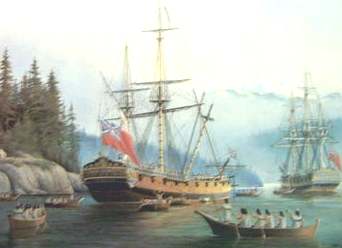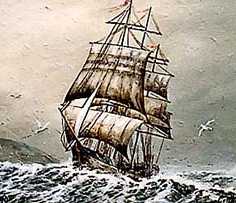|
H.M.S.
Discovery was classified as a sloop carrying fourteen
guns and was rated in navy records as 6th rate. This
type of vessel was originally a coal carrier refitted
for exploration work. Her length was just under one
hundred feet and she had a crew of one hundred. The
DISCOVERY was refitted in 1797 as a bomb ship. Later, in
1827 she became a prison hulk. It is believed she was
broken up in 1834.

HMS
Discovery provisioning
In 1789, the Spanish and
English were at loggerheads over control of lands in the
Pacific Northwest. In anticipation of a favorable
resolution of the Nootka Sound controversy, the English
prepared an expedition to sail under Captain George
Vancouver. The primary aims were to survey "the
direction and extent of all such considerable inlets ...
as may be likely to lead to" a Northwest passage
between Cape Mendocino (30°N) and Cook Inlet (60°N),
and especially "the supposed straits of Juan de
Fuca." The Admiralty furnished two vessels for the
purpose, Discovery (named for the vessel in
which Vancouver sailed as midshipman on Captain James
Cook's last voyage to the Pacific), and Chatham.
The ships departed Falmouth on
April 1, 1791, and sailing east called at Tenerife and
Cape Town, making a landfall at Cape Chatham, Australia,
on September 28. They then rounded Tasmania and landed
at Dusky Bay, New Zealand, on November 2, 1791. From
there they proceeded to Tahiti and, in early March 1792,
Kealakekua Bay, where Cook had been killed in 1779.
After two weeks in the Sandwich Islands, the ships
sailed for North America, arriving off Cape Cabrillo,
130 miles north of San Francisco Bay, on April 17, 1792.
Sailing north, twelve days
later Chatham and Discovery met with
Robert Gray's Columbia,
the first ship they had seen in eight months, and then
sailed into the Strait of Juan de Fuca and proceeded to
Discovery Bay about 70 miles east of Cape Flattery for
repairs. From that base they explored Puget Sound (named
for Second Lieutenant Peter Puget, who commanded Chatham
from November 25, 1792) and the San Juan Islands. Here
they encountered the schooners Sutil
and Mexicana, which were conducting surveys of
the coast in conjunction with Spanish claims to the
area; relations between the English and Spanish were
friendly.
In October, Vancouver turned
south and, leaving Chatham to cross the bar at
the mouth of the Columbia River, proceeded to Yerba
Buena (now San Francisco) where on November 14 Discovery
became the first non-Spanish ship to sail into San
Francisco Bay. The ships remained on the Spanish coast
until January 15, 1793, when they sailed from Mendocino
for Hawaii, arriving on February 12. While in Hawaii,
Vancouver wanted to punish the murder of two men from
the storeship Daedalus who had been killed en
route to Nootka Sound the previous year. He also wanted
to mediate a truce between King Kamehameha and King
Kahekili, and to persuade them to accept the protection
of the King of England. After Chatham sailed
for the Northwest, Discovery remained in Hawaii
making surveys of the islands, including the first of
Pearl Harbor.
Discovery returned to
Nootka, arriving on May 20, two days after Puget had
sailed on an independent survey. The ships continued to
survey Queen Charlotte Sound, including Elcho Harbour on
Dean Channel just two months before Alexander Mackenzie
completed the first crossing of North America north of
Mexico on July 21. By the end of the second season,
Vancouver's expedition had charted 1,700 miles of coast
from 29°56N to about 56°N. During the expedition's
third visit to Hawaii, Vancouver completed his survey of
all of the major Hawaiian islands and Kamehameha
formally put his islands under the protection of Great
Britain.

HMS Discovery under sail
In mid-March 1794, the ships
sailed for Cook's Inlet, Alaska, which Vancouver had
visited in 1778. Discovery and Chatham
separated shortly after departing Hawaii and did not
find each other until May 6. Discovery made a
landfall on Chirikof Island and proceeded to Cook's
Inlet on April 12. After determining it was not a
river—it had been thought a likely candidate for the
Northwest Passage—Vancouver sailed around the Kenai
Peninsula for a survey of Prince William Sound. Farther
east, in Yakutat Inlet, they encountered a party of 900
Russian-led Kodiak Islanders employed in the seal trade.
The Yakutat resented the Russians whom they viewed, in
the words of the expedition's surgeon-botanist Archibald
Menzies, "as intruders in their territories,
draining their shores & coasts of Seals Otter &
Fish on which their subsistence chiefly Depends &
that too without making the least return for their
depredations."
In the late summer, they
completed charting of the northern end of the Alexander
Archipelago, having stopped at Cape Decision at the
southern end of Chichagof Island in 1793. The ships
sailed for California and finally left Monterey on
December 2, 1794. After stops at Maria Magdalena, Cocos
Island, the Galapagos, and Valparaiso, they sailed into
the Atlantic to arrive at St. Helena on July 3. There
they learned that England was at war with Holland, and
Vancouver seized the Dutch East Indiaman Macassar,
which had sailed from Cape Town in ignorance of the
fact. Chatham was dispatched to Brazil as an
escort. Discovery sailed on July 15 and
Vancouver landed in the Shannon on September 13, 1795. Discovery
and Chatham both arrived at Deptford in late
October.
Though Vancouver hoped that his
survey would "remove every doubt, and set aside
every opinion of a north-west passage, or any
water communication navigable for shipping, existing
between the North Pacific, and the interior of the
American continent within the limits of our
researches," the search continued. The expedition
gave names to scores of places, many of which are in use
today. (The city of Vancouver, British Columbia, was not
so named until 1886.) Moreover, in the course of the
five-year voyage, only five of the Discovery's
crew died—only one from disease—and none of Chatham's.
Converted to a bomb in 1799, Discovery was made
a convict ship in 1818 and broken up in 1834 at
Deptford.
|
Ship
(3m). L/B/D: 99.2 keel × 28.3 × 15.5 (30.2m
× 8.6m × 4.7m).
Tons: 330 tons. Hull:
wood.
Comp.: 100. Arm.: 10 × 4pdr, 10
swivels.
Built: Randall &
Brents, London;
1789.
|
USEFUL
LINKS
Resource:
Council for Museums, Archives and &
Libraries http://www.resource.gov.uk/
National Maritime Museum
http://www.nmm.ac.uk/
Whitby Museum http://www.durain.demon.co.uk/
The National Virtual Museum http://www.24hourmuseum.org/
Endeavour Replica http://www.barkendeavour.com.au/
Captain Cook Society http://www.captaincooksociety.com/
Wikipedia
GNU credit

Solar
Cola sponsor this website
|